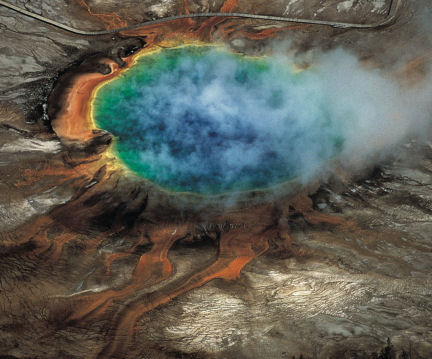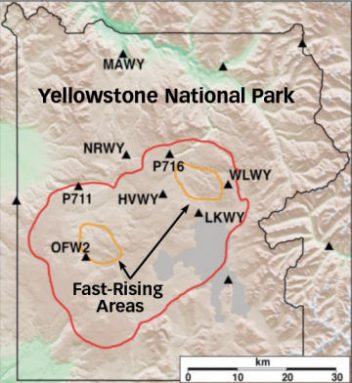The Rise of Yellowstone
New evidence points to a recent, rapid rise of land in parts of Yellowstone National Park.
By Emily Sohn
Yellowstone National Park is an active place—both above ground and underneath it. The park contains more than 10,000 geysers, hot springs, and steaming volcanic vents.
Underground heat fuels this geologic activity in the park’s central basin, says Wu-Lung Chang, a geophysicist at the University of Utah in Salt Lake City. And that heat comes from melted rock that seeps up from deep inside the Earth.
 |
|
Yellowstone’s Grand Prismatic Spring (above) derives heat from an underground reservoir of molten rock.
|
| H. Holdsworth |
Now Chang and colleagues have made a new discovery about the mysteries beneath the park. From mid-2004 through 2006, parts of the land in Yellowstone rose as much as 7 centimeters (2.8 inches) per year. That rise is about three times as fast as any change previously measured in the area.
Scientists began making detailed surveys of Yellowstone’s terrain in 1923. In recent years, new technologies have allowed them to collect even more details.
Over the years, the data have revealed rises and falls over various parts of the park’s landscape. These changes reflect the complicated movement of molten rock and water underground.
Between 1923 and 1995, the terrain shifts averaged between 1 cm (0.4 inch)/year and 1.4 cm (0.6 inch)/year. The shifts started becoming more dramatic between 2000 and 2003. The record-setting rise of land in the Yellowstone basin began in 2004.
 |
|
The red outline in the map (above) shows the location of the Yellowstone basin within the park. The yellow outlines indicate where the flow of molten rock caused a rapid rise in the terrain.
|
| Chang, et al. |
The team’s analyses suggest that a reservoir of molten rock, called a magma chamber, lies about 10 kilometers (6 miles) below the surface of Yellowstone’s central basin. The chamber spreads out under an area of about 1,200 square kilometers (465 square miles).
During the record-setting growth spurt, about 0.1 cubic km (0.02 cubic mile) of molten rock flowed into the chamber. That’s enough rock to fill the Louisiana Superdome about 30 times.
Even though many volcanic eruptions, including some huge ones, have happened in the Yellowstone region, the recent findings don’t suggest that another eruption is about to happen.
Still, the new study offers insights into the underground plumbing of Yellowstone, says Hank Heasler, a National Park Service geologist at Yellowstone’s headquarters in Mammoth, Wyo. The findings, he says, are “very fascinating.”—Emily Sohn
Going Deeper:
Perkins, Sid. 2007. Yellowstone rising: Magma floods into chamber beneath park. Science News 172(Nov. 10):293. Available at http://www.sciencenews.org/articles/20071110/fob5.asp .
Sohn, Emily. 2004. Distant quake changes geyser eruptions. Science News for Kids (June 9). Available at http://www.sciencenewsforkids.org/articles/20040609/Note3.asp .







